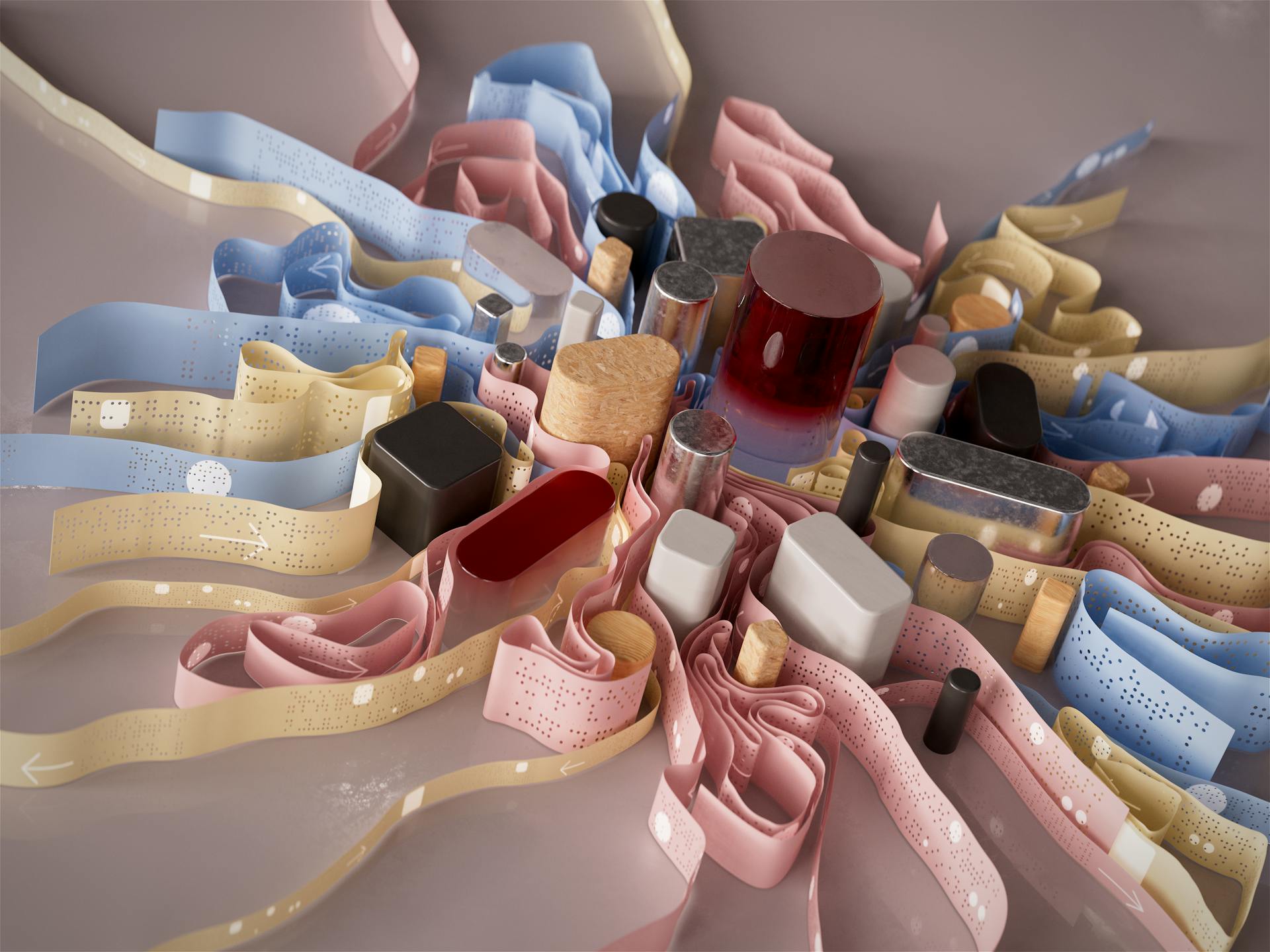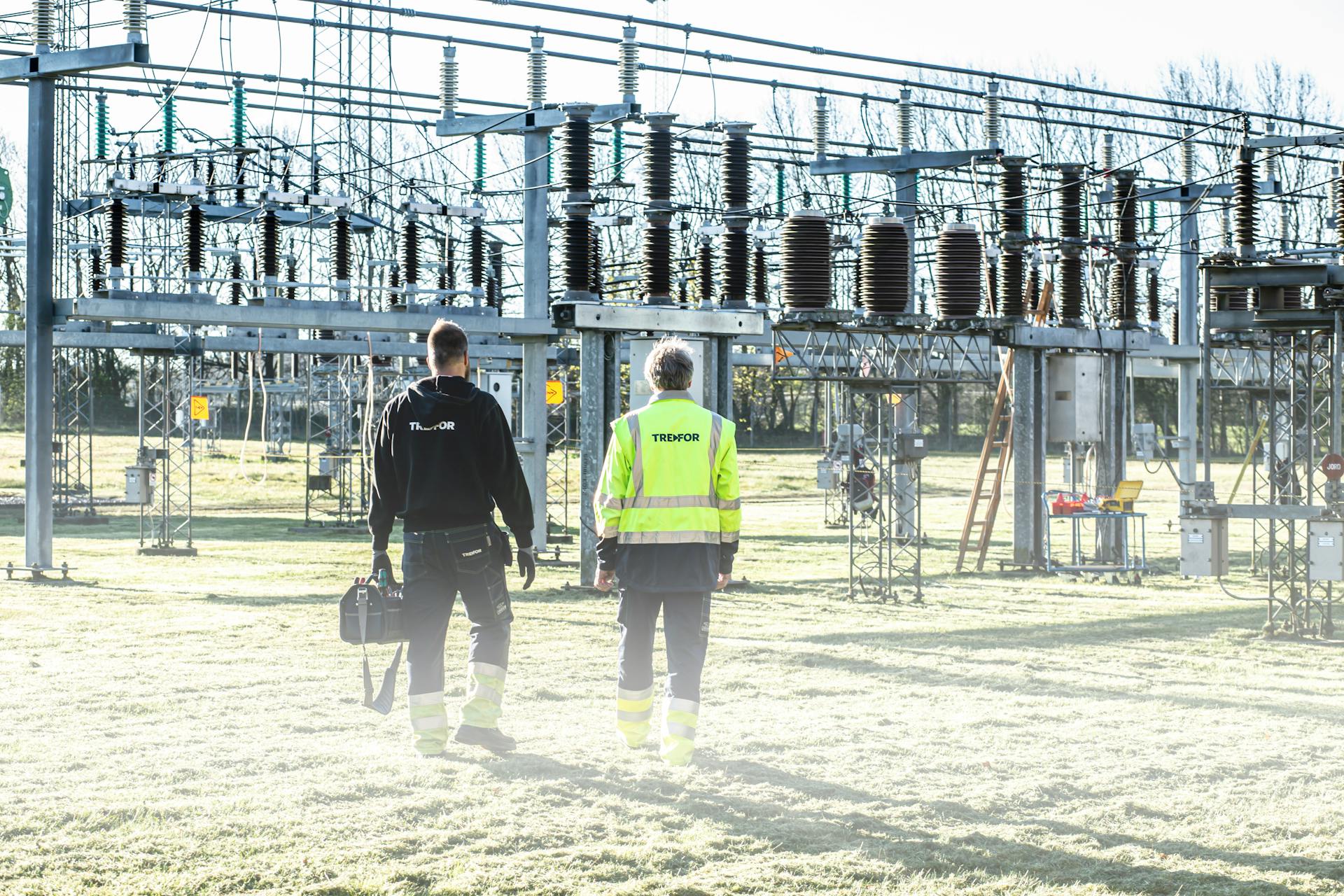
Attention mechanisms are a crucial part of deep learning models, allowing them to focus on specific parts of the input data that are relevant to the task at hand.
They were first introduced in the paper "Neural Machine Translation by Jointly Learning to Align and Translate" by Dzmitry Bahdanau, Kyunghyun Cho, and Yoshua Bengio in 2014.
This innovation revolutionized the field of natural language processing, enabling models to learn more accurately and efficiently.
In essence, attention mechanisms allow a model to weigh the importance of different input elements, giving more importance to the relevant ones.
This is particularly useful in tasks like machine translation, where the model needs to focus on specific words or phrases in the source language to produce accurate translations.
The key to attention mechanisms is the ability to dynamically compute the weights of different input elements, which is made possible by the use of neural networks.
On a similar theme: Hidden Layers in Neural Networks Code Examples Tensorflow
Attention Mechanisms
The Attention Mechanism is a game-changer in natural language processing.
It's a way to focus on the most relevant parts of an input sentence when generating an output. This is achieved by assigning weights to each word in the input sentence based on its importance.
These weights are calculated using a softmax function, which takes the output scores of a feedforward neural network as input. The output scores are calculated by multiplying the input vectors with a matrix and adding a bias term.
The input dimension of the feedforward network is (Tx, 2d), where Tx is the number of words in the input sentence and d is the dimension of the hidden state vectors.
The weights are then used to compute the context vector, which is a weighted sum of the hidden state vectors. The weights are normalized using a softmax function to ensure they add up to 1.
For example, if the weights are [0.2, 0.3, 0.3, 0.2] and the input sentence is "I am doing it", the context vector will be a weighted sum of the hidden state vectors for each word in the sentence.
The Attention Mechanism is particularly useful when the input sentence is long or complex, as it allows the model to focus on the most relevant parts of the sentence.
Check this out: Hidden Layers
Types of Attention
There are several types of attention mechanisms, each designed to cater to specific use cases.
Additive Attention computes attention scores by applying a feed-forward neural network to the concatenated query and key vectors. Dot-Product attention measures attention scores using dot product between the query and key vectors.
The most common types of attention mechanisms include Self-Attention Mechanism, Scaled Dot-Product Attention, Multi-Head Attention, and Location-Based Attention.
Types of Models in Deep Learning
Attention mechanisms have been a game-changer in deep learning, allowing models to focus on relevant parts of the input data. This has been made possible by the work of researchers like Colin Cherry, who studied selective attention in the context of audition, also known as the cocktail party effect.
The filter model of attention, proposed by Donald Broadbent in 1958, is a key milestone in the development of attention mechanisms. This model has inspired algorithms like the Neocognitron and its variants, which use handcrafted features to guide a second neural network in processing patches of the image.
For your interest: Bayesian Learning Mechanisms
The Neocognitron's use of handcrafted features is an early example of how attention mechanisms can be used to improve the performance of neural networks. In contrast, more recent approaches like the unnormalized linear Transformer use learned features to compute weight changes.
There are several types of attention mechanisms used in deep learning, including self-attention, scaled dot-product attention, multi-head attention, and location-based attention. These mechanisms can be used in a variety of tasks, from natural language processing to image-related tasks.
Here are some key characteristics of each type of attention mechanism:
These attention mechanisms have been inspired by the work of researchers in neuroscience and cognitive psychology, who have studied selective attention in humans. By understanding how attention works in the human brain, we can create more effective attention mechanisms for deep learning models.
Bahdanau (Additive)
Bahdanau (Additive) Attention is a type of attention mechanism that computes attention scores by applying a feed-forward neural network to the concatenated query and key vectors. This is a key difference from other attention mechanisms, such as Dot-Product attention.
The Bahdanau attention mechanism is defined as Attention(Q,K,V)=softmax(e)V, where e=tanh (WQQ+WKK) and WQ and WK are learnable weight matrices. This formula shows how the attention scores are computed using the weighted sum of the query and key vectors.
Bahdanau attention is a type of additive attention, which means it computes attention scores by adding up the contributions of different parts of the input. This is in contrast to dot-product attention, which computes attention scores by taking the dot product of the query and key vectors.
Here's a quick summary of the Bahdanau attention mechanism:
The Bahdanau attention mechanism is a powerful tool for handling long sequences and improving overall model performance. By focusing on relevant parts of the input data, models can achieve better results in tasks such as speech recognition and image captioning.
Masked
Masked attention is a variant of QKV attention used in autoregressive decoders.
This variant uses a strictly upper triangular mask, M, with zeros on and below the diagonal and −∞ in every element above the diagonal.
The mask ensures that the softmax output is lower triangular, with zeros in all elements above the diagonal.
This means that for all i
The permutation invariance and equivariance properties of standard QKV attention do not hold for the masked variant.
Architecture
The attention mechanism architecture is a crucial component of machine translation. It involves three main components: Encoder, Attention, and Decoder.
The Encoder processes the input sequence and generates hidden states. These hidden states are then used by the Attention component to compute the relevance between the current target hidden state and the encoder's hidden states.
The Decoder takes the context vector generated by the Attention component and uses it to generate the output sequence. This architecture allows the model to focus on different parts of the input sequence during the translation process, improving the alignment and quality of the translations.
The attention mechanism architecture can be broken down into three sub-parts or components:
- Encoder
- Attention
- Decoder
There are two main types of attention mechanisms: Additive Attention and Dot-Product attention.
Machine Translation Architecture
Machine translation is a complex process that involves multiple components working together to produce accurate and fluent translations. The Attention Mechanism Architecture is a key component of machine translation, which involves three main components: Encoder, Attention, and Decoder.
The Encoder processes the input sequence and generates hidden states, which are then used by the Attention component to compute the relevance between the current target hidden state and the encoder's hidden states. This is done to capture the relevant information from the encoder's hidden states.
The Attention mechanism was grafted onto the seq2seq structure in 2014, revolutionizing machine translation. This allowed models to focus on specific words or phrases in the source language while generating the target language.
Machine translation models can now handle long sentences or paragraphs with ease, thanks to the Attention mechanism. This has greatly improved translation accuracy and fluency.
The Encoder component of the Attention Mechanism Architecture applies recurrent neural networks (RNNs) or transformer-based models to iteratively process the input sequence. This generates a hidden state at each step that contains the data from the previous hidden state and the current input token.
Here are the three main components of the Attention Mechanism Architecture:
- Encoder
- Attention
- Decoder
The Encoder creates a hidden state at each step that contains the data from the previous hidden state and the current input token. This is done using RNNs or transformer-based models.
Check this out: Hidden Technical Debt in Machine Learning Systems
Feed Forward Network
The feed-forward network is a crucial component in transforming the target hidden state into a representation that's compatible with the attention mechanism. It's essentially a simple neural network with one hidden layer.
The input for this network is quite straightforward: it takes the previous decoder state and the output of the encoder states.
In a feed-forward neural network, a linear transformation is applied followed by a non-linear activation function, such as ReLU. This helps to extract useful features from the input data.
Here's a breakdown of the input for the feed-forward network:
- Previous Decoder state
- The output of Encoder states.
This simple yet effective architecture allows the feed-forward network to produce a new representation that's compatible with the attention mechanism.
Variants and Applications
Attention mechanisms have many variants, each with its own strengths and applications. One notable variant is Bahdanau-style attention, also known as additive attention.
The variants of attention can be distinguished by the dimension on which they operate, such as spatial attention, channel attention, or combinations. For example, positional attention and factorized positional attention are two variants that focus on spatial attention.
In real-world applications, attention mechanisms have made a significant impact in various domains, including machine translation, image captioning, speech recognition, and question answering. They enhance translation accuracy, enable models to describe image content accurately, improve speech transcription, and help models focus on relevant information in the text while generating answers.
Some of the main applications of the attention mechanism include NLP tasks like machine translation, text summarization, and question answering, as well as computer vision tasks like image classification and object detection.
Real-World Applications
Attention mechanisms have made a significant impact in various domains, including machine translation, image captioning, speech recognition, and question answering.
In machine translation, attention mechanisms enhance translation accuracy by focusing on relevant parts of the source language text.
For example, in speech recognition, attention mechanisms improve speech transcription, even in noisy environments, by understanding context.
Attention mechanisms have been successfully applied to NLP tasks like machine translation, text summarization, and question answering.
On a similar theme: Pattern Recognition
Some of the key applications of attention mechanisms include:
- Machine Translation: They enhance translation accuracy by focusing on relevant parts of the source language text.
- Image Captioning: They enable models to describe image content accurately, adding contextual information.
- Speech Recognition: By understanding context, they improve speech transcription, even in noisy environments.
- Question Answering: They help models focus on relevant information in the text while generating answers.
Improving Deep Learning Model Performance
Attention Mechanisms address critical challenges in deep learning, including handling long sequences effectively, ensuring contextual understanding, and achieving improved overall model performance.
By enabling models to focus on relevant parts of input data, Attention Mechanisms make them highly efficient in processing complex information. This is particularly useful in tasks involving sequences like natural language processing.
There are several types of Attention Mechanisms used in deep learning, including Self-Attention Mechanism, Scaled Dot-Product Attention, Multi-Head Attention, and Location-Based Attention.
To give you a better idea of how these types of Attention Mechanisms work, here's a brief overview:
Attention Mechanisms have made a substantial impact in various domains, including Machine Translation, Image Captioning, Speech Recognition, and Question Answering.
Transformers
The Transformer architecture was a game-changer in the field of deep learning, and it's all thanks to the power of attention mechanisms. It was published in the Attention Is All You Need paper in 2017, bringing together various strands of development that had been happening in the field.
The Transformer architecture was a response to the limitations of seq2seq models, which used recurrent neural networks that couldn't be parallelized. This meant that both the encoder and decoder had to process the sequence token-by-token, making it a slow and inefficient process.
The Transformer architecture solved this problem by using self-attention mechanisms, which allowed for parallel processing and computation of a "soft alignment matrix". This enabled the model to focus on relevant parts of the input sequence, making it highly efficient in processing complex information.
One of the key components of the Transformer architecture is the Scaled Dot-Product Attention mechanism, which calculates attention scores by taking the dot product of a query vector and the keys, followed by scaling and applying a softmax function. This type of attention mechanism is highly efficient and has contributed to the success of Transformers in various applications.
Here are some key types of attention mechanisms used in deep learning:
- Self-Attention Mechanism: Used in tasks involving sequences like natural language processing.
- Scaled Dot-Product Attention: An efficient mechanism that’s a key component of the Transformer architecture.
- Multi-Head Attention: Allows models to focus on different parts of input data simultaneously.
- Location-Based Attention: Commonly used in image-related tasks, assigning attention based on spatial location.
The Transformer architecture has been widely adopted in various applications, including question-answering systems. These systems, like those used in chatbots or virtual assistants, benefit from attention mechanisms as they help the model focus on relevant parts of the input text while generating responses, leading to more contextually accurate and coherent answers.
Implementing Attention
Implementing attention mechanisms is a crucial step in developing effective deep-learning models. You can use popular libraries like TensorFlow or PyTorch to add an attention layer to your model.
To implement attention mechanisms, you'll need to use a programming language like Python. TensorFlow is a popular choice, and you can add an attention layer to your model using the provided Python code example.
The attention layer can be implemented using different types of attention mechanisms and architectures. You can experiment with various options to find the best fit for your specific task.
To start implementing attention mechanisms, you'll need to calculate the attention for individual words in a sequence. This can be done using libraries like Numpy and SciPy.
You can calculate the attention for the first four words in a sequence of four, and then generalize the code to calculate the attention output for all four words in matrix form. The number of rows of each matrix and dimensionality of the word embeddings are equal.
Generating weight matrices is another crucial step in implementing attention mechanisms. You can do this by multiplying the word embedding to generate the queries, keys, and values.
Check this out: Confusion Matrix Tensorflow
Advantages and Disadvantages
The attention mechanism is a powerful tool for improving the performance of deep learning models. It has several key advantages that make it a valuable addition to any model.
One of the main advantages of the attention mechanism is improved accuracy. By allowing the model to pay attention to the most relevant information, the attention mechanism can help to improve the accuracy of predictions.
The attention mechanism can also make the model more efficient. It can reduce the computational resources required and make the model more scalable, which is especially important for large and complex tasks.
Improved interpretability is another advantage of the attention mechanism. The attention weights learned by the model can provide insight into which parts of the data are the most important, which can help improve the model's interpretability.
However, the attention mechanism also has some disadvantages that should be considered.
The attention mechanism can be challenging to train, especially for large and complex tasks. This is because the attention weights must be learned from the data, which can require a large amount of data and computational resources.
For more insights, see: Computational Learning Theory
Regularization techniques can help mitigate the problem of overfitting, but it can still be challenging when working with large and complex tasks. Overfitting occurs when the model performs well on the training data but not on new data.
Exposure bias is another problem that can occur with the attention mechanism. It occurs when the model is trained to generate the output sequence one step at a time, but at test time, it is required to generate the entire sequence at once. This can lead to poor performance on the test data.
Here are the main advantages and disadvantages of the attention mechanism:
- Improved accuracy
- Improved efficiency
- Improved interpretability
- Difficulty of training
- Overfitting
- Exposure bias
Conclusion
Attention mechanisms have transformed a wide range of applications, from machine translation to image captioning.
The key to mastering attention mechanisms lies in practice and experimentation. This is because trying different types of attention and exploring various architectures is crucial for success.
Attention mechanisms can help your models achieve levels of performance that were once thought to be beyond reach, with the right focus.
Remember to keep an eye on the latest research and developments in this exciting field, as the world of deep learning is constantly evolving.
Happy deep learning!
Suggestion: Deep Learning Coursera Andrew Ng
Sources
- https://en.wikipedia.org/wiki/Attention_(machine_learning)
- https://www.geeksforgeeks.org/ml-attention-mechanism/
- https://medium.com/@zhonghong9998/attention-mechanisms-in-deep-learning-enhancing-model-performance-32a91006092a
- https://www.analyticsvidhya.com/blog/2019/11/comprehensive-guide-attention-mechanism-deep-learning/
- https://www.scaler.com/topics/deep-learning/attention-mechanism-deep-learning/
Featured Images: pexels.com


